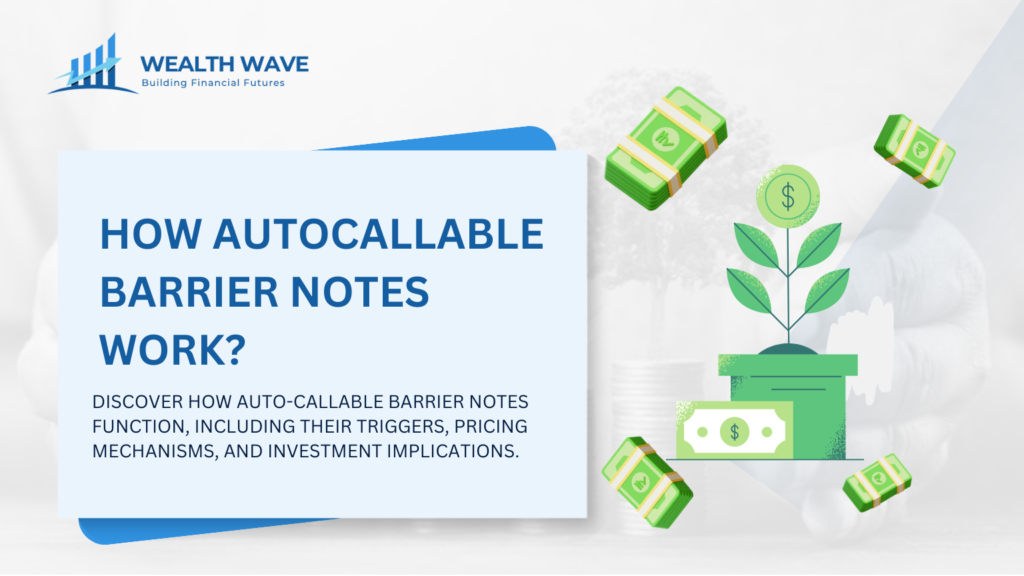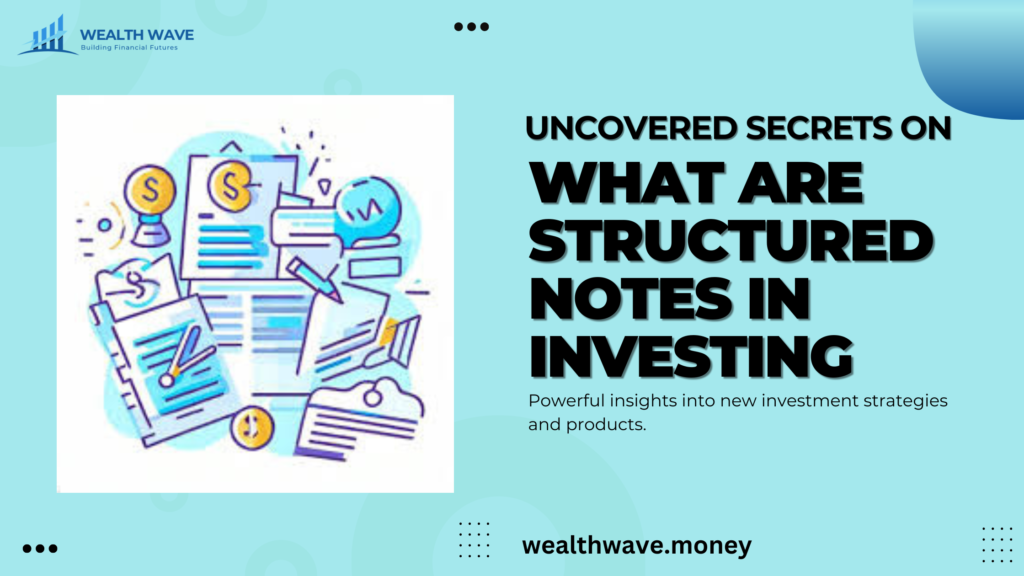
Many of our readers have been on the hunt for ways to amp up their investment income, and a hot topic that keeps surfacing is autocallable barrier notes. Like many of you, we were intrigued by the notion that most autocallable notes tend to be redeemed just a few years after they’re issued – it’s an eye-opener that nudged us to dive deeper into these financial instruments.
So, we rolled up our sleeves and plunged into the world of autocallable barrier notes, yield notes, and structured products to really get a grip on how they tick. Our deep dive aims to break down these concepts into plain English.
We’re talking about unpacking potential perks and pitfalls so you can figure out if this type of investment aligns with your financial aspirations. Essentially, we’re here to guide you through making savvy choices about beefing up your income stream with market-linked investments such as autocallable structured product options or callable marketlinked growth notes.
Are you ready for a clearer perspective on your investment possibilities?
Key Takeaways
- Autocallable barrier notes offer enhanced income through periodic coupon payments. These notes link to market performance, aiming for yields above traditional options.
- Investors face risks with autocallable notes as they may not receive any coupon if the underlying asset underperforms. Most of these notes redeem before reaching maturity.
- These financial products include principal protection features and allow investors to express views on market trends by setting a reference barrier.
- Callable bonds and structured notes share similarities with autocallable notes but come with their own set of risks related to issuer call actions and underlying asset performances.
- Understanding the specific risk factors and how these investments align with personal financial goals is crucial for making informed decisions about including autocallable barrier notes in portfolios.
Understanding Autocallable Notes

Understanding autocallable notes offers us unique insights into market-linked investments. These financial products feature the potential for enhanced yields while providing some level of principal protection.
General Description

Autocallable barrier notes, or autocallable yield notes (ACYNs), are unique investment products. They are not widely known to the public. These notes pay out a coupon to bondholders.
This periodic payment rewards investors for holding the notes. Investors express a view on whether a reference rate exceeds a set barrier. Most autocallable notes do not reach maturity; they often get redeemed within a couple of years of issuance.
These investments fall under the category of market-linked investments. They aim to enhance income relative to traditional income-generating options.
Principal Protection

Principal protection forms a key feature of autocallable barrier notes. These notes often provide a safety net for investors. They allow us to express confidence in whether a specific reference rate will surpass a designated barrier.
Most autocallable notes do not reach maturity and typically redeem within a few years of issuance. This short duration can enhance our control over capital.
We enjoy the benefit of enhanced income potential through autocallable contingent coupon barrier notes. These notes offer yields above traditional income-generating investments. They also carry risks, especially if the stock falls below the reference barrier.
Investors should assess these risk factors thoroughly to determine the suitability of autocallable notes in their portfolios.
Enhanced Yield
Autocallable notes offer enhanced income potential compared to traditional investments. These instruments pay out a regular coupon to bondholders, making them attractive for income-seeking investors.
The structure allows us to gain higher yields through market-linked growth notes. We can benefit from returns that exceed typical market rates, particularly with autocallable step-up barrier notes.
However, we face risks, such as not receiving a coupon if the reference rate does not perform as expected. Understanding how these features interact helps us evaluate investment opportunities effectively.
Next, we will explore the risks and considerations involved with autocallable barrier notes.
Important Features
Autocallable barrier notes have several important features that investors should know. These investment products can provide enhanced income potential through their contingent coupon structure.
Typically, they pay out a periodic coupon to bondholders. This delivers attractive returns compared to traditional income-generating investments.
Investors express views on market trends with these notes. They can set a reference barrier to determine if the investment is performing well. Most autocallable notes redeem before reaching maturity, often within a couple of years.
This trait makes them unique as compared to callable bonds and structured notes. Overall, these features support a yield enhancement strategy for those investing in capital markets.
Risks and Considerations

Investors must carefully assess the risks associated with market-linked investments, as these products can bring unique challenges and complexities. We encourage you to read more to gain deeper insights into this topic.
Autocallable Market-linked Investments
Autocallable market-linked investments provide unique opportunities for income generation. These investments, like autocallable barrier notes, deliver coupon payments to bondholders.
They link their performance to specific reference rates. Investors express their views on whether these rates will exceed set barriers. We can analyze autocallable notes for potential investment benefits and risks.
Most autocallable notes do not reach maturity. Instead, they often redeem within a couple of years. Autocallable contingent coupon barrier notes can offer enhanced income potential compared to traditional income-generating options.
They provide a yield-enhancing strategy that aims for an above-market yield. However, investors may face the risk of not receiving any coupon if the stock underperforms. Understanding these dynamics helps us make informed decisions about including market-linked investments in our portfolio.
Callable Bonds and Structured Notes
Callable bonds and structured notes share some similarities with autocallable barrier notes. We can use callable bonds as an investment tool that allows issuers to redeem the bond before maturity.
Investors receive periodic coupon payments, but they might face risks if the issuer decides to call the bond, especially if market rates change.
Structured notes combine traditional debt instruments with derivatives. These notes can offer customized features and payouts based on their underlying assets. They can provide investors with a unique way to access market-linked investments.
However, they also carry risks related to option pricing and the performance of the underlying equities.
Derivatives and Financial Products
We often encounter derivatives and financial products in the investment landscape. These instruments can enhance our portfolios alongside autocallable notes. An autocallable option can tap into enhanced yield while linking to market performance.
Derivatives allow us to express views on market movements. We should keep in mind that investing in market-linked investments comes with specific risks.
Some products, like barrier options and equity-linked notes, provide unique opportunities for potential returns. Autocallable structured notes also fit into this category. They can cater to our investment strategies, offering benefits that traditional bonds may not provide.
By analyzing the risk factors associated with these financial solutions, we can make informed choices that align with our goals.
How Autocallable Barrier Notes Work
Autocallable barrier notes offer unique investment opportunities. They provide potential income while managing risk effectively.
Potential Investment Benefits
Autocallable barrier notes offer several potential benefits for investors. They provide enhanced income potential, which can be appealing compared to traditional income-generating investments.
These notes often pay a coupon to bondholders. This periodic payment can add regular income to our portfolios.
Investors can take advantage of market-linked growth notes. These notes allow us to express views on whether a reference rate will exceed a specific barrier. Most autocallable notes redeem within a couple of years of issue.
This feature helps us manage risk while pursuing attractive yields. We can find valuable insights on pricing and options for such investments from resources like Investopedia.
Enhanced Income Potential
We see enhanced income potential in autocallable barrier notes. These notes can offer higher returns compared to traditional income-generating investments. They pay bondholders periodic coupons, providing consistent income.
With autocallable contingent coupon barrier notes, we can enjoy even more attractive yields. This yield-enhancing strategy allows investors to receive above-market returns. However, the risk remains that we might not receive any coupon if conditions are unfavorable.
Market-linked investments like these require us to carefully analyze risks and assess suitability for our investment goals.
Risk Management
We must understand the risks tied to autocallable barrier notes. These notes may not reach maturity. Often, they redeem within a few years of issue. While they offer enhanced income potential, several risks exist.
The risk of not receiving any coupon arises if the stock performs poorly. Therefore, we must analyze the risk factors carefully to assess suitability.
Market-linked investments, including autocallable structured notes, come with various risks. Investors should evaluate how these products fit their financial goals. We find that knowledge about these investments helps us make informed decisions.
Familiarity with equity-linked notes also aids in risk management. Resources like Investopedia can guide us in understanding pricing and options associated with autocallable notes.
Is an Autocallable Barrier Note Right for You?

Some investors may find these notes appealing due to their potential for income and enhanced yields. Others might feel uneasy about the risks involved, so we should consider our individual risk tolerance carefully.
Suitable for Investors Who Want Income
Autocallable barrier notes attract investors seeking income. These notes pay out a coupon, which is a periodic payment made to bondholders. They offer enhanced income potential compared to traditional income-generating investments.
Most autocallable notes do not reach their maturity date. Instead, they redeem within a couple of years. This quick turnaround can provide us with regular income.
Investors can express a view on whether a specific reference rate will exceed a set reference barrier. With this structure, we may earn an above-market yield. Autocallable contingent coupon barrier notes allow us to take advantage of market-linked investments while managing risks.
Understanding these elements helps us make informed decisions about our investment strategy.
May Be Risky for Risk-Averse Investors
Investors who avoid risk should approach autocallable barrier notes with caution. These notes can offer enhanced income potential, but they come with specific challenges. Most autocallable notes do not reach maturity.
They often redeem within a couple of years of issuance. Investors may find it risky to rely on the periodic coupon payments. If the reference rate does not exceed the set barrier, we risk not receiving any coupon.
This situation can lead to disappointment for those seeking steady income.
Market-linked investments like autocallable step-up barrier notes pose additional risks. While they may enhance income, they are tied to market performance. Risk-averse investors should analyze these factors carefully.
Understanding potential risks helps us make informed decisions about whether to include these in our investment banking strategy.
Important Factors to Consider
We must think about several factors when considering autocallable barrier notes. These investment products offer potential benefits, such as enhanced income relative to traditional income-generating investments.
Barrier notes pay out a coupon, which gives us periodic payments. However, we need to recognize that most autocallable notes do not reach maturity. They often redeem within a couple of years.
Market-linked investments like these can carry significant risks. If the underlying stock price falls, we may not receive any coupon payments. This yield-enhancing strategy is appealing, but it requires careful risk analysis.
Making informed choices about equity-linked notes can help us avoid undesired pitfalls in our investment journey.
Conclusion

Autocallable barrier notes offer unique benefits for investors. They provide a chance for higher yields compared to traditional bonds. Understanding their risks helps us make informed decisions.
We can find further details on platforms like Investopedia. By exploring these notes, we may uncover new opportunities for our portfolios.
FAQs
Q1. What are autocallable barrier notes?
Ans. Autocallable barrier notes are a type of market-linked investments, often linked to equities or equity indices.
Q2. How do autocallable barrier notes work?
Ans. These financial instruments pay interest until they reach their call date. If the value of the underlying equity is above a certain level on that date, they’re automatically redeemed.
Q3. Can you lose money with autocallable barrier notes?
Ans. Yes, if the underlying equity falls below a set “barrier”, investors could potentially lose part or all of their initial investment in these market-linked securities.
Q4. Are autocallable barrier notes and equity-linked notes the same thing?
Ans. No, while both are types of marketlinked investments and can be tied to equities, they function differently; Equity-linked notes offer potential returns based on an index’s performance without automatic redemption features found in Autocallables.




